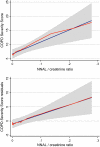Longer term exposure to secondhand smoke and health outcomes in COPD: impact of urine 4-(methylnitrosamino)-1-(3-pyridyl)-1-butanol
- PMID: 19587064
- PMCID: PMC2711983
- DOI: 10.1093/ntr/ntp091
Longer term exposure to secondhand smoke and health outcomes in COPD: impact of urine 4-(methylnitrosamino)-1-(3-pyridyl)-1-butanol
Abstract
Introduction: Secondhand smoke (SHS) contains respiratory irritants and has the potential to adversely affect adults with chronic obstructive pulmonary disease (COPD), but few studies have evaluated the impact of SHS on COPD.
Methods: We used data from 72 nonsmoking participants in a cohort study of COPD. Urine 4-(methylnitrosamino)-1-(3-pyridyl)-1-butanol (NNAL) was measured as an indicator of longer term SHS exposure, whereas urine cotinine was assessed as a measure of more recent exposure. The impact of SHS exposure on COPD-related health status was examined using multivariate linear regression (controlling for age, sex, race, educational attainment, and smoking history). Health status was measured using a validated COPD severity score, reported dyspnea, a standard health status measure (Short Form-12), and activity restriction.
Results: The urine NNAL-to-creatinine ratio (per interquartile increment) was associated with greater COPD severity (mean score increase 1.7 points; 95% CI 0.6-2.8; p = .0003). Higher urine NNAL was also related to greater dyspnea, poorer physical health status, and more restricted activity (p < or = .05 in all cases). When considered simultaneously, longer term exposure (NNAL) had a greater negative impact on COPD status than shorter term exposure (cotinine).
Discussion: Urine NNAL can be used to estimate longer term SHS exposure and negatively affects a number of health outcomes among adults with COPD. Screening for and prevention of SHS exposure among persons with COPD may be beneficial.
Figures


Similar articles
-
Effect of maternal tobacco smoking or exposure to second-hand smoke on the levels of 4-(methylnitrosamino)-1-(3-pyridyl)-1-butanol (NNAL) in urine of mother and the first urine of newborn.J Physiol Pharmacol. 2011 Jun;62(3):377-83. J Physiol Pharmacol. 2011. PMID: 21893699
-
Directly measured secondhand smoke exposure and COPD health outcomes.BMC Pulm Med. 2006 Jun 6;6:12. doi: 10.1186/1471-2466-6-12. BMC Pulm Med. 2006. PMID: 16756671 Free PMC article.
-
Comparison of Urine 4-(Methylnitrosamino)-1-(3)Pyridyl-1-Butanol and Cotinine for Assessment of Active and Passive Smoke Exposure in Urban Adolescents.Cancer Epidemiol Biomarkers Prev. 2018 Mar;27(3):254-261. doi: 10.1158/1055-9965.EPI-17-0671. Epub 2018 Feb 23. Cancer Epidemiol Biomarkers Prev. 2018. PMID: 29475963 Free PMC article.
-
Exposure to different sources of second-hand smoke during pregnancy and its effect on urinary cotinine and tobacco-specific nitrosamine (NNAL) concentrations.Tob Control. 2013 May;22(3):194-200. doi: 10.1136/tobaccocontrol-2011-050144. Epub 2012 Jan 17. Tob Control. 2013. PMID: 22253001
-
Smoking status and second-hand smoke biomarkers in COPD, asthma and healthy controls.ERJ Open Res. 2020 Jul 20;6(2):00192-2019. doi: 10.1183/23120541.00192-2019. eCollection 2020 Apr. ERJ Open Res. 2020. PMID: 32714953 Free PMC article. Review.
Cited by
-
High Levels of the Carcinogenic Tobacco-Specific Nitrosamine NNAL and Associated Findings in Children of Smokers: A Case Series.Biomark Insights. 2022 Aug 11;17:11772719221118868. doi: 10.1177/11772719221118868. eCollection 2022. Biomark Insights. 2022. PMID: 35982916 Free PMC article.
-
Comparison of urine cotinine and the tobacco-specific nitrosamine metabolite 4-(methylnitrosamino)-1-(3-pyridyl)-1-butanol (NNAL) and their ratio to discriminate active from passive smoking.Nicotine Tob Res. 2011 Mar;13(3):202-8. doi: 10.1093/ntr/ntq237. Epub 2011 Jan 21. Nicotine Tob Res. 2011. PMID: 21330276 Free PMC article.
-
Recent contributions of air- and biomarkers to the control of secondhand smoke (SHS): a review.Int J Environ Res Public Health. 2011 Mar;8(3):648-82. doi: 10.3390/ijerph8030648. Epub 2011 Mar 1. Int J Environ Res Public Health. 2011. PMID: 21556172 Free PMC article. Review.
-
Elimination kinetics of the tobacco-specific biomarker and lung carcinogen 4-(methylnitrosamino)-1-(3-pyridyl)-1-butanol.Cancer Epidemiol Biomarkers Prev. 2009 Dec;18(12):3421-5. doi: 10.1158/1055-9965.EPI-09-0874. Cancer Epidemiol Biomarkers Prev. 2009. PMID: 19959691 Free PMC article.
-
Metabolites of a tobacco-specific lung carcinogen in children exposed to secondhand or thirdhand tobacco smoke in their homes.Cancer Epidemiol Biomarkers Prev. 2011 Jun;20(6):1213-21. doi: 10.1158/1055-9965.EPI-10-1027. Epub 2011 Apr 5. Cancer Epidemiol Biomarkers Prev. 2011. PMID: 21467230 Free PMC article. Clinical Trial.
References
-
- Alemayehu B, Aubert RE, Feifer RA, Paul LD. Comparative analysis of two quality-of-life instruments for patients with chronic obstructive pulmonary disease. Value in Health. 2002;5:436–441. - PubMed
-
- Anderson KE, Kliris J, Murphy L, Carmella SG, Han S, Link C, et al. Metabolites of a tobacco-specific lung carcinogen in nonsmoking casino patrons. Cancer Epidemiology, Biomarkers and Prevention. 2003;12:1544–1546. - PubMed
-
- Barr RG, Herbstman J, Speizer FE, Camargo CA., Jr. Validation of self-reported chronic obstructive pulmonary disease in a cohort study of nurses. American Journal of Epidemiology. 2002;155:965–971. - PubMed
-
- Benzo R, Flume PA, Turner D, Tempest M. Effect of pulmonary rehabilitation on quality of life in patients with COPD: The use of SF-36 summary scores as outcomes measures. Journal of Cardiopulmonary Rehabilitation. 2000;20:231–234. - PubMed
Publication types
MeSH terms
Substances
Grants and funding
LinkOut - more resources
Full Text Sources
Medical

